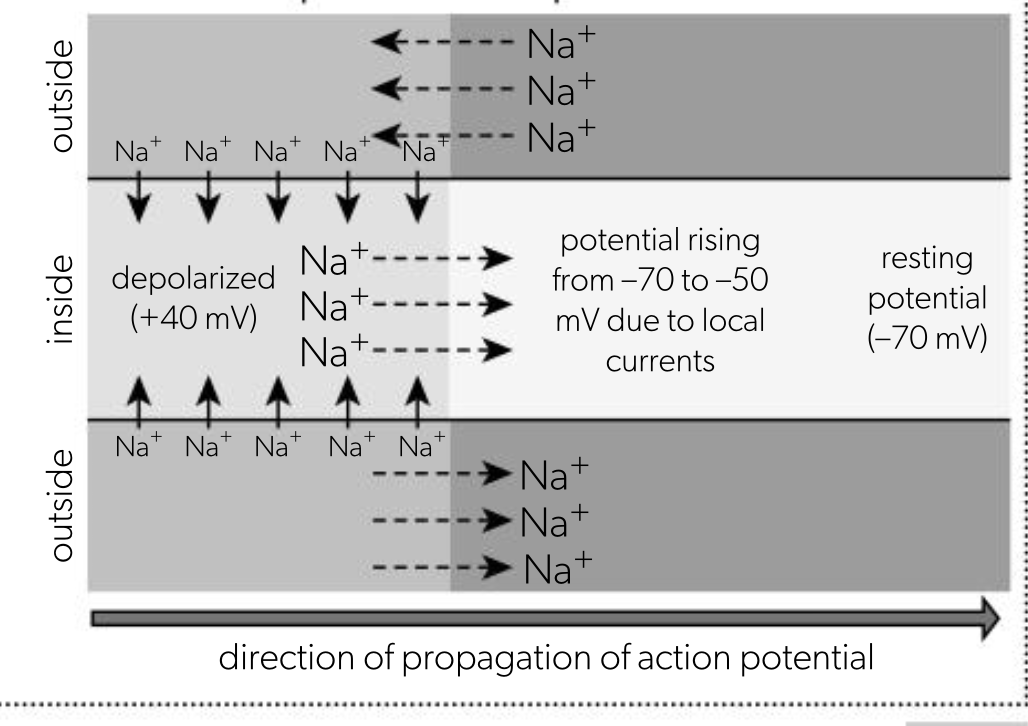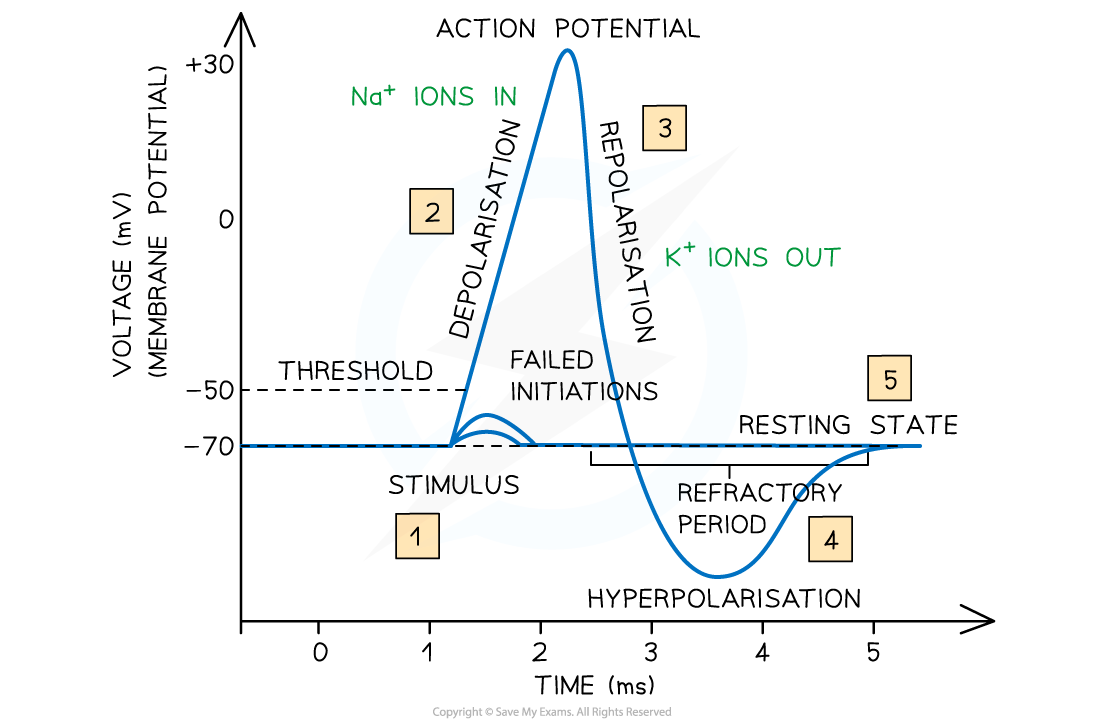Neural signalling
1/22
There's no tags or description
Looks like no tags are added yet.
Name | Mastery | Learn | Test | Matching | Spaced |
|---|
No study sessions yet.
23 Terms
nervous system
central nervous system - brain and spinal cord
peripheral nervous system - all of the nerves in the body
neurones
have main, long fibre - axon
axon is insulated by Schwann cells forming the myelin sheath
have cell body containing nucleus and other cell structure
cell bodies and axon terminals contain extensions - dendrites
dendrites allow to connect to many other neurones and receive impulses

generating resting potential
neurones transmit information through impulses which travel quickly from neurone to neurone
impulses are a momentary reversal in the electrical p.d across neurone cell surface membrane
in an axon not transmitting an impulse, the inside of axon has negative electrical potential, and outside has positive electrical potential
this membrane potential in resting neurone is called the resting potential
2 processes which establish and maintain resting potential
active transport of sodium and potassium ions
difference in rates of diffusion of sodium and potassium ions
active transport of sodium and potassium ions
sodium-potassium pumps are present in cell surface membrane of neurone
pumps use ATP to transport Na+ out of axon and K+ into axon
3 Na+ pumped out, 2 K+ pumped in - generates concentration gradient across membrane
difference in rates of diffusion of sodium and potassium ions
due to conc gradient generated by sodium potassium pump, both K+ and Na+ will diffuse back across membrane through facilitated diffusion
neurone membrane much less permeable to Na+ than K+, so K+ can diffuse out at a faster rate than Na+ can diffuse in
this results in more positive ions on the outside than the inside
nerve impulses
once resting potential reached, neurone is polarised
to initiate nerve impulse in neurone, it must be depolarised
the reversal of electrical p.d across membrane
depolarisation of membrane occurs when action potential is generated
rapid movement of Na+ and K+ across membrane of axon
action potential: changes in voltage produced across axon membrane during nerve impulse
factors affecting speed of transmission
myelination of neurone
myelinated neurones conducted impulsed much quicker than unmyelinated fibres
small gaps between Schwann cells - nodes of Ranvier, allow impulse to jump from one node of another, speeding up transmission along axon
diameter of neurone
axon with wider diameter conducts impulse quicker than a narrow axon
wider axon offers less resistance
squid have giant unmyelinated axons, despite being significantly wider, the speed of transmission is much faster in axon which is insulated by myelin sheath
myelination
schwann cells wrapped around axon form the myelin sheath
myelin sheath acts as electrical insulator
synapses
2 neurones never meet, instead a very small gap called synaptic cleft separates them
2 neurones and synaptic cleft form a synapse
synapses - junctions between any cells in the nervous system
ensure one-way transmission of impulses because neurotransmitter is released on one side and its receptors are on the other
release of excitatory neurotransmitters
impulse arrives at the end of axon on presynaptic neurone, membrane of presynaptic neurone becomes depolarised, triggering release of Ca+ into presynaptic cell via Ca+ channels
influx of Ca+ in presynaptic membrane causes vesicles containing neurotransmitter to moves forward to membrane where they fuse w/ it and release neurotransmitters into synaptic cleft by exocytosis
neurotransmitters diffuse across synaptic cleft and bind w/ receptor molecules on postsynaptic membrane
generating excitatory postsynaptic potential, example: ACh
ACh is released into synaptic cleft when ACh containing vesicles fuse w/ presynaptic membrane
ACh binds to receptors on postsynaptic membrane, causing the receptor proteins to change conformation, allowing Na+ to flow through
Na+ diffuse down their conc gradient across postsynaptic membrane causing membrane potential to become less negative
if potential rises from -70 mV to -50 mV, an action potential is triggered in the postsynaptic neurone
to prevent Na+ channels staying permanently open and to stop permanent depolarisation of postsynaptic membrane, ACh is broken down and recycled
depolarisation
some ion channels of neurone are voltage gated, meaning they open/close in response to changes in electrical potential
voltage gated Na+ channels open if the membrane potential rises from -70 mV to -50mV - action potential is generated
Na+ moves into axon down conc gradient, raising membrane potential further
if enough Na+ enters axon and membrane potential is raised enough, more Na+ channels open, and more Na+ flows in
this causes membrane potential to rise from -50 mV to around 30/40 mV
action potential threshold
action potential only initiated if the threshold potential is reached
nerve impulse is “all or nothing”, because unless threshold potential is reached, there is no action potential
if the voltage reaches around -50 mV, the threshold potential is reached and the voltage gated Na+ channels can open
how action potential is propagated
once generated, action potential is propagated along length of axon
this movement happens because an action potential in 1 part of the axon triggers an action potential in the next part, this occurs due to local currents
local currents are movements of Na+ by diffusion between one part of axon that has depolarised, and adjacent part that is still polarised
this movement makes the potential in the still polarised region less negative
if potential in membrane rises from -70 mV to threshold potential, voltage gated Na+ channels start to open triggering action potential

repolarisation
positive membrane potential developed during depolarisation causes voltage-gated K+ channels to open
K+ diffuses out of axon down conc gradient
movement of K+ ions causes inside of axon to become negatively charged again - repolarisation
membrane potential returns to -70 mV and may briefly overshoot by becoming more negative than this, before Na+/K+ pump restablishes conc gradients - this is hyperpolarisation
interpreting oscilloscope traces
resting potential at -70 mV
action potential causes a spike rising up to +30/40 mV
instead of repolarisation causing the membrane potential to return immediately to normal resting potential of -70 mV, the trace shows a short period of hyperpolarisation
when membrane potential becomes more negative than resting potential

saltatory conduction
the presence of myelin increases the speed at which action potentials travel along the neurone
in section of axon surrounded by myelin sheath, depolarisation cannot occur as the myelin sheath stops the diffusion of Na+ and K+
small, uninsulated sections of the axon - nodes of Ranvier, contain clusters of ion pumps and channels allowing the action potential to occur
action potentials jump from one node to another - saltatory conduction
neonicotinoids - exogenous chemical
synthetic compounds similar to nicotine commonly found in pesticides
block synaptic transmission at cholinergic synapses in insects by binding to ACh receptors
ACh is unable to bind, stopping impulses from being transmitted, leading to death in insects
cocaine - exogenous chemical
blocks reuptake of neurotransmitters into presynaptic neurone
cocaine primarly affects reuptake of dopamine as it binds to dopamine transporter protein, preventing it from moving back into presynaptic neurone
dopamine builds up in synapses, leading to feelings of pleasure
also blocks neurotransmitters serotonin and norepinephrine
inhibitory postsynaptic potentials
neurotransmitters that prevent generation of action potential in postsynaptic neurone
neurotransmitter opens a gated K+ channel in membrane so K+ is able to diffuse out
postsynaptic neurone becomes hyperpolarised
threshold isn’t reached, so action potential can’t be triggered
summation of neurotransmitter effects in postsynaptic neurone
initiation of an action potential is an “all-or-nothing” event
a single release of excitatory neurotransmitter from one neurone is often insufficient to trigger action potential, bc it doesn’t cause threshold potential to be reached
to reach threshold, neurone must release neurotransmitter multiple times in short time, or several neurones must release neurotransmitter simultaneously - this is summation
perception of pain
pain receptors have free nerve endings which are unencapsulated
nerve endings have channels for positively charged ions which open in response to stimulus e.g temperature, acid or chemicals e.g capsaicin in chilli peppers
entry of positively charged ions causes threshold potential to be reached and action potential to be generated
impulse passes through neurones to the brain
consciousness
emergent properties: result of interactions between the elements of a system
interactions between neurones lead to consciousness